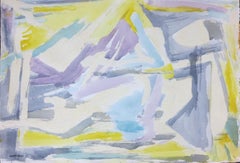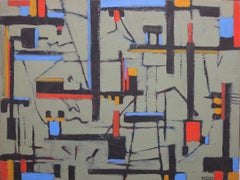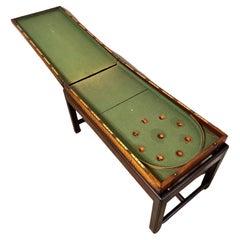Murray Hantman On Sale
Mid-20th Century Abstract Expressionist Abstract Paintings
Watercolor
Mid-20th Century Abstract Geometric Abstract Paintings
Canvas, Oil
People Also Browsed
Antique Late 19th Century Victorian Game Tables
Brass
1960s Cubist Figurative Paintings
Canvas, Oil, Gouache, Board
2010s Naturalistic Figurative Paintings
Oil, Board
1950s Abstract Expressionist Abstract Paintings
Canvas, Oil
1940s Abstract Geometric Abstract Paintings
Paper, Encaustic
Vintage 1940s American Expressionist Paintings
Board
1950s Abstract Expressionist Abstract Paintings
Canvas, Oil
Charles Ragland BunnellComposition in Red and Blue - Abstract Expressionist 1950s Oil Painting, 1951
1950s Modern Abstract Prints
Lithograph
1950s Abstract Expressionist Abstract Paintings
Canvas, Oil
Vintage 1950s French Mid-Century Modern Contemporary Art
Paper
1920s Impressionist Landscape Paintings
Oil, Canvas
1910s Realist Interior Paintings
Linen, Oil
Late 20th Century Contemporary Nude Paintings
Copper
Early 1900s American Impressionist Landscape Paintings
Oil, Canvas
1950s Modern Figurative Paintings
Ink, Screen, Paper
1950s Modern Landscape Prints
Lithograph
Recent Sales
1950s Abstract Expressionist Abstract Paintings
Acrylic
Murray Hantman for sale on 1stDibs
Shaped by his life experiences and a commitment to the practice of making art, the work of Murray Hantman represented a career of personal exploration and aesthetic refinement that took him from New York to Los Angeles, back to New York and eventually to the serene, yet dramatic, the coast of Maine, where he worked as part of the artists’ colony on Monhegan Island. Born in Pennsylvania in 1904, Hantman’s family moved many times to follow his father’s business opportunities, eventually settling in New York. A childhood of economic instability and dislocation formed Murray Hantman’s early years, making him independent and self-reliant from a very early age. Hantman’s father owned movie theatres and photography studios and, recognizing his son’s artistic ability, employed him to print hand-color photographs as a child. When he was eleven and living in Michigan, a public school teacher arranged for Hantman to receive a scholarship to the Detroit Museum of Art School, where after a year he was awarded another scholarship to study at the Detroit School of Design. He studied in Detroit for a year until his family abruptly moved to Alabama, interrupting his artistic and academic studies until the family moved to New York at the end of the first World War. As a young man, Hantman supported himself by working many different jobs in New York and New Jersey. Steady work with his brother at the Hartford and New Haven Railroad office in New York City finally allowed Hantman to pursue his artistic studies formally. In 1928, he enrolled in the Art Students League and became part of a social circle of artists and activists. While at the Art Students League, he worked with faculty members Boardman Robinson and Thomas Hart Benton on two mural projects. During the years around the Great Depression, Hantman worked in Los Angeles with a group of artists known as the Bloc of Painters. Recruited through an advertisement to attend a course on fresco painting, the Bloc group was headed by Mexican muralist David Alfaro Siqueiros, who had recently been exiled from Mexico for political activism. Through his work with Siqueiros, Hantman became motivated by social and political issues and their creative expression. In 1934, He returned to New York and found the community of artists there equally engaged in social justice issues. While enrolling at the newly-formed Artists’ Union to advocate for the labor rights of creative workers, Hantman met sculptor Jo Levy who would become his wife. Like many artists at the time, he found work through the Federal Art Project as a member of the Easel Painting Division, which strove to create “works of art for the public which have a definite social value to the community”. Along with the work he exhibited as a member of the WPA group, Hantman’s work from this period was in the style of Social Realism he learned from Siqueiros. Hantman and his wife, Jo Levy, believed in creating art for the public good. Their Artists’ Union friends and colleagues from the Federal Art Project formed the nucleus of their social circle and would become the community of artists who worked together during summers on Monhegan Island off the coast of Maine. In 1945, Hantman had his first solo painting show at Marquee Gallery in New York and visited Monhegan Island for the first time. The following summer, he and Levy spent the summer in Maine and would continue to do so for the next thirty years. The landscapes and seascapes of Maine would become a central subject in his work after 1946. The dramatic coastline of Monhegan Island had been an inspiration for other New York artists before Hantman, including George Bellows and Rockwell Kent. As Hantman matured as an artist he began to reject academic narrative in his work, moving towards a more expressionistic and abstract style. During this shift into abstraction, nature remained central to his work and the seascape and Maine light provided continual inspiration. In the late 1940s, Hantman began to reduce the landscape into elemental forms of color and shape. As he pursues this mode of painting, his work moves further into abstraction, juxtaposing large blocks of saturated color to convey the drama of sea and sky. Always a student and teacher, Hantman distilled the ideologies of Abstract Expressionism and synthesized its concepts into his work. Throughout the 1950s, he experimented with Action Painting, color, form and expression. By the late 1950s, Hantman’s mature style had developed into abstract works of pure color masses in simple geometric forms. His mastery of color and form continued into his late work, always reflecting the beauty of the natural world around him. Dedicated to the idea of exploration in his art, Hantman made hundreds of small color and form studies that hint at the large-scale works that would follow in the late 1960s and beyond. Hantman’s work from the ‘70s and ‘80s shows even more intensity of color and distillation of composition. The landscape of the Maine coast remained his muse throughout, the stark lines suggesting the flat plane of sea and horizon line beyond. Hantman and Jo Levy lived in New York and summered on Monhegan Island until 1975, followed by summers in Owls Head and New Harbor, Maine, until 1988, the year of his last solo exhibition, at the Portland Museum of Art. In 1989, Hantman showed with Levy in a group exhibition. Levy died in 1996, followed by Hantman in 1999.
A Close Look at Abstract Art
Beginning in the early 20th century, abstract art became a leading style of modernism. Rather than portray the world in a way that represented reality, as had been the dominating style of Western art in the previous centuries, abstract paintings, prints and sculptures are marked by a shift to geometric forms, gestural shapes and experimentation with color to express ideas, subject matter and scenes.
Although abstract art flourished in the early 1900s, propelled by movements like Fauvism and Cubism, it was rooted in the 19th century. In the 1840s, J.M.W. Turner emphasized light and motion for atmospheric paintings in which concrete details were blurred, and Paul Cézanne challenged traditional expectations of perspective in the 1890s.
Some of the earliest abstract artists — Wassily Kandinsky and Hilma af Klint — expanded on these breakthroughs while using vivid colors and forms to channel spiritual concepts. Painter Piet Mondrian, a Dutch pioneer of the art movement, explored geometric abstraction partly owing to his belief in Theosophy, which is grounded in a search for higher spiritual truths and embraces philosophers of the Renaissance period and medieval mystics. Black Square, a daringly simple 1913 work by Russian artist Kazimir Malevich, was a watershed statement on creating art that was free “from the dead weight of the real world,” as he later wrote.
Surrealism in the 1920s, led by artists such as Salvador Dalí, Meret Oppenheim and others, saw painters creating abstract pieces in order to connect to the subconscious. When Abstract Expressionism emerged in New York during the mid-20th century, it similarly centered on the process of creation, in which Helen Frankenthaler’s expressive “soak-stain” technique, Jackson Pollock’s drips of paint, and Mark Rothko’s planes of color were a radical new type of abstraction.
Conceptual art, Pop art, Hard-Edge painting and many other movements offered fresh approaches to abstraction that continued into the 21st century, with major contemporary artists now exploring it, including Anish Kapoor, Mark Bradford, El Anatsui and Julie Mehretu.
Find original abstract paintings, sculptures, prints and other art on 1stDibs.
Finding the Right abstract-paintings for You
Bring audacious experiments with color and textures to your living room, dining room or home office. Abstract paintings, large or small, will stand out in your space, encouraging conversation and introducing a museum-like atmosphere that’s welcoming and conducive to creating memorable gatherings.
Abstract art has origins in 19th-century Europe, but it came into its own as a significant movement during the 20th century. Early practitioners of abstraction included Wassily Kandinsky, although painters were exploring nonfigurative art prior to the influential Russian artist’s efforts, which were inspired by music and religion. Abstract painters endeavored to create works that didn’t focus on the outside world’s conventional subjects, and even when artists depicted realistic subjects, they worked in an abstract mode to do so.
In 1940s-era New York City, a group of painters working in the abstract mode created radical work that looked to European avant-garde artists as well as to the art of ancient cultures, prioritizing improvisation, immediacy and direct personal expression. While they were never formally affiliated with one another, we know them today as Abstract Expressionists.
The male contingent of the Abstract Expressionists, which includes Jackson Pollock, Willem de Kooning and Robert Motherwell, is frequently cited in discussing leading figures of this internationally influential postwar art movement. However, the women of Abstract Expressionism, such as Helen Frankenthaler, Lee Krasner, Joan Mitchell and others, were equally involved in the art world of the time. Sexism, family obligations and societal pressures contributed to a long history of their being overlooked, but the female Abstract Expressionists experimented vigorously, developed their own style and produced significant bodies of work.
Draw your guests into abstract oil paintings across different eras and countries of origin. On 1stDibs, you’ll find an expansive range of abstract paintings along with a guide on how to arrange your wonderful new wall art.
If you’re working with a small living space, a colorful, oversize work can create depth in a given room, but there isn’t any need to overwhelm your interior with a sprawling pièce de résistance. Colorful abstractions of any size can pop against a white wall in your living room, but if you’re working with a colored backdrop, you may wish to stick to colors that complement the decor that is already in the space. Alternatively, let your painting make a statement on its own, regardless of its surroundings, or group it, gallery-style, with other works.




